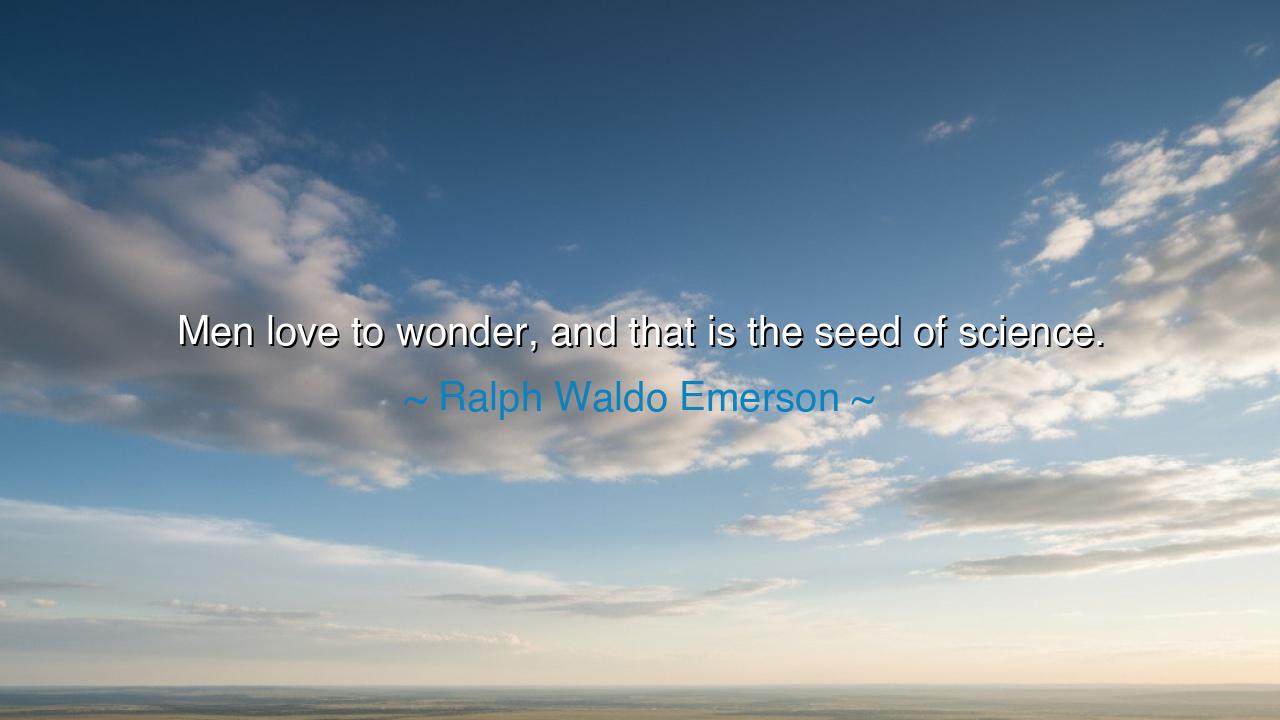
Men love to wonder, and that is the seed of science.






"Men love to wonder, and that is the seed of science." These words from Ralph Waldo Emerson capture the very essence of the scientific spirit—a spirit driven not by cold calculation but by the wonder and curiosity that reside deep within the human soul. From the dawn of time, humanity has been drawn to the mysteries of the world, gazing upon the stars, the rivers, the mountains, and the heavens, and asking, "Why?" It is through this wonder, this deep sense of awe, that the seeds of science are sown. Emerson reminds us that science begins not in the laboratory, not in theory, but in the most primal of human instincts—the instinct to marvel at the world and seek to understand it.
In the ancient world, the great minds of Greece and Egypt were driven by a similar impulse. Thales of Miletus, one of the first philosophers, gazed at the world around him and wondered what the basic substance of everything was. Pythagoras, in his search for the underlying order of the universe, asked how numbers governed the world. These thinkers were not driven by practical needs but by a deep curiosity—a longing to understand the patterns that underpinned reality. They marveled at the simplicity and complexity of existence, and from their wonder sprang the first steps toward philosophy and science. The desire to know, to wonder, to question was the seed from which the tree of human knowledge began to grow.
Similarly, Aristotle is a shining example of how wonder can lead to scientific discovery. As he looked at the natural world, from the flight of birds to the growth of plants, Aristotle’s mind was filled with questions—what made these things move, grow, and change? His pursuit of answers to these questions laid the foundation for many areas of science. Aristotle’s biology, for instance, was built on a curiosity about the natural world and a profound wonder about the interrelationships between living creatures. His investigations were rooted not in a desire for power or control, but in the humble pursuit of understanding, driven by the wonder he felt in the face of nature’s infinite complexity.
Leonardo da Vinci, the Renaissance polymath, provides another example of how wonder nurtured the seeds of science. Leonardo's notebooks are filled with sketches of flying machines, anatomical studies, and observations on the flow of water—all born from his deep wonder about the world. His relentless curiosity led him to ask questions that few others had even thought to pose. Da Vinci's investigations into the human body, for instance, were not for the sake of medicine alone, but to understand the intricacies of life itself. Through his wonder and keen observation, he bridged the gap between art and science, showing us how imagination can be the conduit for scientific discovery.
This relationship between wonder and science is also evident in the story of Isaac Newton and his discovery of the laws of motion and gravity. It is said that Newton was inspired by the simple act of watching an apple fall from a tree. That seemingly ordinary event filled him with wonder, and from that moment, he sought to understand the forces that governed the fall of objects. His wonder about the forces of nature led to the creation of the most profound scientific theories the world has ever known. Science begins in the heart of the observer, in the question, "Why does this happen?" It is from this question that the path of discovery begins.
Emerson’s words also highlight the importance of curiosity in our modern lives. In today’s world, the drive to wonder can often be overshadowed by practicality—by the drive to achieve, produce, or conform. Yet, as Emerson teaches us, it is the act of wondering that nurtures the seeds of all great advancements, whether in science, art, or philosophy. It is this questioning spirit that challenges the status quo, propels humanity forward, and inspires us to look beyond what is immediately visible. In this world of constant information, we must not lose our sense of awe and wonder, for it is through these that we find the most profound answers and are led to new realms of discovery.
The lesson here is timeless: we must learn to embrace our own sense of wonder and curiosity, both in the pursuit of knowledge and in the simple joy of discovery. Whether in science, art, or our personal lives, we must never lose sight of the questions that stir our hearts—the "Why?" that drives us to explore the mysteries of existence. Let us approach the world with the eyes of a child, seeing the marvels around us and asking questions that lead to deeper understanding. In doing so, we keep the flame of inquiry burning brightly, and we ensure that the seeds of science continue to grow, pushing humanity ever forward into new realms of knowledge and enlightenment.
So, let us honor the spirit of wonder in our own lives. Let us allow curiosity to lead us, just as it led the great thinkers of the past. In every question we ask, in every moment of awe we experience, we cultivate the seeds of discovery, whether in the study of the stars or the exploration of the human soul. May we never lose the wonder that has driven human progress for millennia, for in this wonder lies the very heart of science itself.






AAdministratorAdministrator
Welcome, honored guests. Please leave a comment, we will respond soon